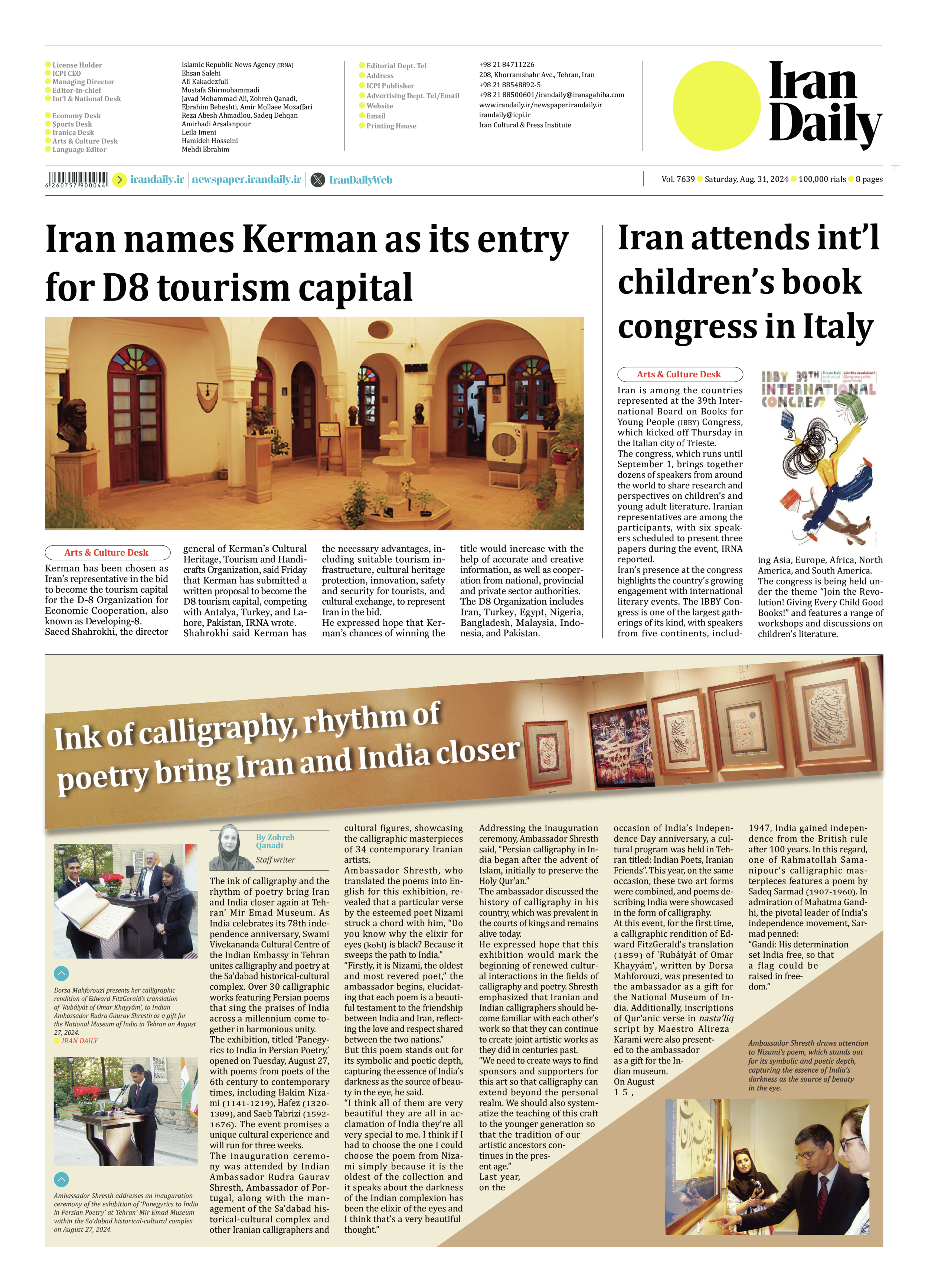
Copy in clipboard...
Ink of calligraphy, rhythm of poetry bring Iran and India closer
The exhibition, titled ‘Panegyrics to India in Persian Poetry,’ opened on Tuesday, August 27, with poems from poets of the 6th century to contemporary times, including Hakim Nizami (1141-1219), Hafez (1320-1389), and Saeb Tabrizi (1592-1676). The event promises a unique cultural experience and will run for three weeks.
The inauguration ceremony was attended by Indian Ambassador Rudra Gaurav Shresth, Ambassador of Portugal, along with the management of the Sa’dabad historical-cultural complex and other Iranian calligraphers and cultural figures, showcasing the calligraphic masterpieces of 34 contemporary Iranian
artists.
Ambassador Shresth, who translated the poems into English for this exhibition, revealed that a particular verse by the esteemed poet Nizami struck a chord with him, “Do you know why the elixir for eyes (kohl) is black? Because it sweeps the path to India.”
“Firstly, it is Nizami, the oldest and most revered poet,” the ambassador begins, elucidating that each poem is a beautiful testament to the friendship between India and Iran, reflecting the love and respect shared between the two nations.”
But this poem stands out for its symbolic and poetic depth, capturing the essence of India’s darkness as the source of beauty in the eye, he said.
“I think all of them are very beautiful they are all in acclamation of India they’re all very special to me. I think if I had to choose the one I could choose the poem from Nizami simply because it is the oldest of the collection and it speaks about the darkness of the Indian complexion has been the elixir of the eyes and I think that’s a very beautiful
thought.”
Addressing the inauguration ceremony, Ambassador Shresth said, “Persian calligraphy in India began after the advent of Islam, initially to preserve the Holy Qur’an.”
The ambassador discussed the history of calligraphy in his country, which was prevalent in the courts of kings and remains alive today.
He expressed hope that this exhibition would mark the beginning of renewed cultural interactions in the fields of calligraphy and poetry. Shresth emphasized that Iranian and Indian calligraphers should become familiar with each other’s work so that they can continue to create joint artistic works as they did in centuries past.
“We need to create ways to find sponsors and supporters for this art so that calligraphy can extend beyond the personal realm. We should also systematize the teaching of this craft to the younger generation so that the tradition of our artistic ancestors continues in the present age.”
Last year, on the occasion of India’s Independence Day anniversary, a cultural program was held in Tehran titled: Indian Poets, Iranian Friends”. This year, on the same occasion, these two art forms were combined, and poems describing India were showcased in the form of calligraphy.
At this event, for the first time, a calligraphic rendition of Edward FitzGerald’s translation (1859) of 'Rubáiyát of Omar Khayyám', written by Dorsa Mahforouzi, was presented to the ambassador as a gift for the National Museum of India. Additionally, inscriptions of Qur'anic verse in nasta’liq script by Maestro Alireza Karami were also presented to the ambassador as a gift for the Indian museum.
On August 15, 1947, India gained independence from the British rule after 100 years. In this regard, one of Rahmatollah Samanipour’s calligraphic masterpieces features a poem by Sadeq Sarmad (1907-1960). In admiration of Mahatma Gandhi, the pivotal leader of India’s independence movement, Sarmad penned:
“Gandi: His determination set India free, so that a flag could be raised in freedom.”







